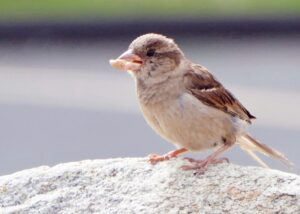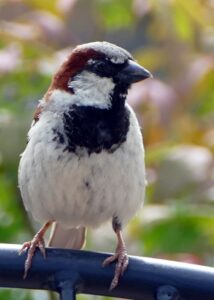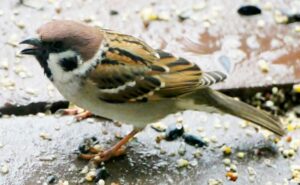Eurasian Tree Sparrows and House Sparrows – Similarities and Differences
Cleon and I live in central Illinois and range maps in field guides or online – especially those published before 2012 – can show that we are out of this bird’s range. The Eurasian Tree Sparrow is not native to North America, but was introduced in St. Louis and established itself in the city and its suburbs. About 25 years or more years ago, a small colony established itself in Petersburg, IL. I know this because one of my cousins lives just outside Petersburg and these birds started coming to her feeders. About 5 years ago, I started to see them at our feeders. First it was just 2-3. Now, it appears we have a stable flock of

about 15-20. They are year-round residents, so are nesting and wintering here. And, they seem to have displaced the House Sparrows.
We have lived here almost 20 years and from the beginning, we have had House Sparrows. The small flock quickly grew from about 6 to over 30. In the 5 years the Eurasian Tree Sparrows have been here, the House Sparrows have declined in number until we only counted 2 pairs in our back yard. Both pairs disappeared from our feeders, bird baths, and yard in mid-summer 2023. About 8 House Sparrows did return to the feeders in January 2024 during our days of temperatures at 0 ºF and below, but as soon as the temperatures were back in the 20’s, they disappeared from the feeders again. Did the Eurasian Tree Sparrows displace them? Out-compete them for nesting sites? Push the House Sparrows from their territories? We do not know. If you have House Sparrows in your yard or favorite park and have spent time observing them, you know they are aggressive and relentless so to imagine the Eurasian Tree Sparrows are even more so is hard to believe, but it may be true.

Wherever you live, and if you have House Sparrows, do not assume the flock of House Sparrows you observe is just that – all House Sparrows. The Eurasian Tree Sparrow appears to be expanding its range. Look at the face of each male House Sparrow in the flock and look for a black spot on the cheek. If there is one, the bird is a Eurasian Tree Sparrow. Some references state Eurasian Tree Sparrows and House Sparrows do not flock together – they do in our yard on the platform

feeder and on the ground under the feeders. This is a big problem for birders. If birds would just read their entries in the field guides and act accordingly, birding would be so much easier!
Male and female Eurasian Tree Sparrows look alike – unlike the male and female House Sparrow who look decidedly different. But notice how much the Eurasian Tree Sparrow looks like the male House Sparrow. If I see a back view, to my eye, these birds look exactly alike. The way I tell them apart is to look for that black spot on the cheek. In addition, the House Sparrow has a gray head stripe the Eurasian Tree Sparrow lacks. The Eurasian Tree Sparrow has a black chin, but never a black bib. The House Sparrow has a black chin, but a black bib only in spring and summer. In fall and winter, there is only a trace of a bib or no bib at all.
Many species of birds are declining in population – including the House Sparrow. The Eurasian Tree Sparrow is a good example of a bird that is increasing in population and extending its range.

